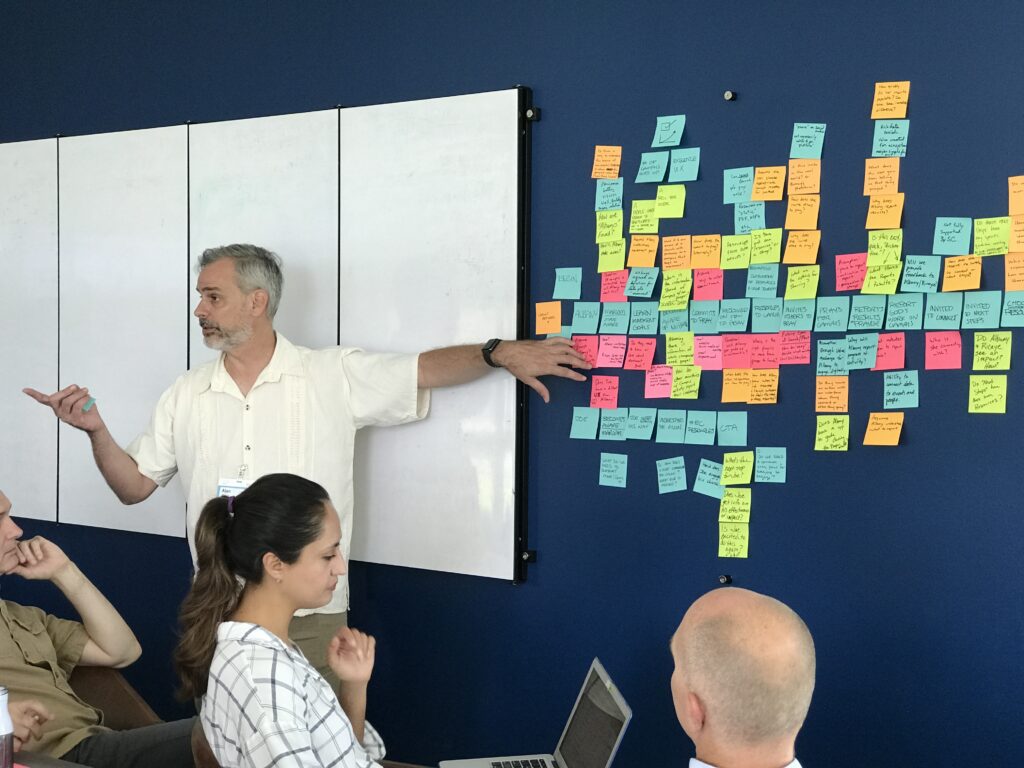It’s exciting when it’s time for a new website or app for your ministry. So exciting that you might be tempted to dive right into wireframes or even the build itself.
But every successful project begins with understanding the needs of the people your product will serve. And identifying the outcome needed to both please your end users and meet your organization’s goals. It begins with Discovery.
Let’s explore why Discovery is an essential phase of your next project—and the five steps to do it right.
What Is Discovery?
You have a project in mind: Your organization needs a new website, app, or other digital solution to move the needle on your mission. You may have even submitted RFPs to a handful of developers.
Discovery kicks off your project by getting the right people in a room to figure out precisely what needs to be done and how to do it.
Importantly, Discovery is always completed from a user-centered perspective to ensure the final product reflects the optimal user experience.
When Does Discovery Take Place?

Kicking off your project implies that Discovery is at the beginning of your work. And that’s true the vast majority of the time. However, larger projects occasionally require an additional Discovery phase partway through the project to validate your path.
Ideally, Discovery is its own project phase—independent of any building and optimization that might take place later. We conduct Discovery this way for two main reasons:
- It enables a more accurate scope and budget for the rest of your project.
- Discovery is useful in its own right, helping to build consensus and chart a clear path forward.
Discovery is the shortest, straightest path from an initial idea to a fully fledged, user-centered concept your whole team feels good about pursuing. That level of detail is required to map out a clear plan—and an accurate budget.
We can’t say how long it will take to get somewhere until we’ve decided whether we’re popping out to the grocery store or road tripping cross country. The same goes for your ministry’s budget. Discovery is key to solidifying your project’s scope. Only then can we say with certainty how much it will cost.
It’s worth noting that Discovery is a valuable tool even if you don’t immediately pursue a project. You’ll receive helpful deliverables post-Discovery (a plan, budget, and takeaways from key session moments) to shop around both internally and externally.
Internally, you can garner project buy-in from board members with your Discovery assets in hand. Externally, you can share Discovery findings with other developers to get their take on your project. We’re confident in the results this important phase yields.
Why Is Discovery Crucial?
It’s common to assume everyone in your ministry is on the same page about what your digital project must achieve. In reality, diverse stakeholders naturally have competing priorities.
Without Discovery, these varying priorities may never surface—or they’ll surface when you’re too far into your build to pivot easily. With Discovery, you’ll have the discussions necessary to reach internal alignment and foster transparency about your project. You may not agree on every tiny detail but it’s vital that everyone is rowing in the same direction.
Another downside of bypassing Discovery? You risk building a product users aren’t interested in. Discovery elevates the end user’s perspective. Without it, you might not see the full picture of what your constituents need.
5 Essential Discovery Steps
We’ve found a way to construct Discovery sessions so that even clients unfamiliar with Discovery or lacking confidence in their ability to contribute get meaningful results.
This method includes five proprietary steps: Framing, Empathy, Journey, Exploration, and Product Backbone. We’ll detail each below. The order of these steps is very much intentional. Each builds on the last to create a narrative arc that informs your project from start to finish.
1. Framing

The Framing step is all about figuring out what we’re trying to accomplish and how that vision will be brought to life. We’ll frame the challenge in clear and concise terms and set the stage for understanding your organization’s goals and how they relate to your target audience, whether that’s parishioners, volunteers, missionaries, or other pastoral professionals.
If you have an RFP, we’ll make sure the entire group is up to speed on what we knew before we even sat down together—and align as needed. We also conduct framing activities, such as card sorting.
Card sorting involves writing down proposed project features or concepts on sticky notes. From there, we’ll work together to arrange the notes in four quadrants. The four quadrants indicate which features are the most important and which will be the most difficult to create.
This exercise—and the Framing step in general—help surface the true challenges and priorities we need to pay attention to for the rest of our work together.
2. Empathy
We’re not building a site or app for ourselves. We’re building it for the people your product will serve. The Empathy step of Discovery elevates this critical user perspective, increasing your team’s understanding of and empathy for your constituents.
In a perfect world, you’d get out into the field for user research. But even if that isn’t in your budget, we will use Discovery to craft personas (profiles describing specific, like-minded groups within your target audience) that capture users as accurately as possible.
To develop your personas, we’ll discuss commonalities among your audience, concerns they share, and what makes them unique. We’ll name the personas and refine them as we discover more about your users, ultimately searching for what motivates them.
If we sense a disconnect between your organization and your audience, we may also complete an empathy map. We’ll brainstorm each persona’s hopes and what they’re afraid of to put your team squarely in your users’ shoes.
You’re driven by a worthy mission. And you’re never trying to make a quick buck. To succeed in that vital mission, you need—and want—to help people. Personas are a useful tool to understand how to help.
3. Journey
During the Journey step, we’ll pinpoint problem areas along a user’s journey (how they get from point to point using your product) that can impede a successful user experience. Then we’ll mitigate these problems. We’ll also spotlight high points of the user journey to identify when users are most open to taking next steps with your organization. We’ll do both by completing a journey map.
A journey map describes each interaction—from first contact through to conversion—a user can have with your ministry. It charts an ideal user’s relationship with your organization over time.
This Discovery step will help your team grasp just how far-reaching the user journey is. It’s never about a single interaction. You must constantly think about how one touchpoint builds upon another. This holistic understanding of the user journey gives us a more complete picture of your project.
4. Exploration

With your journey map in hand, it’s time to brainstorm how to facilitate each step on the map for the best possible user experience. This exercise tends to be the most divergent in the sense that we encourage everyone to share their ideas without attempting to align right away. We want all those ideas on the table so we can eventually converge on the perfect solution.
To get to that perfect solution, we leverage charrettes and dot voting. Your team will get a stack of paper and sharpies to sketch key moments from the user journey map, like when an individual is ready to learn more about your organization. You’ll then sketch possible solutions.
Each solution sketch will go on display and dot voting will begin. Your stakeholders can place dot stickers on elements of the sketches they find worthy of further exploration. We’ll rinse and repeat (sketches followed by dot voting) until the best solution(s) bubbles to the top.
5. Product Backbone
The goal of Exploration is to tap into your team’s collective wisdom. The best solution often leads to your Product Backbone.
Your Product Backbone is essentially a features list. What does your website or app actually need to include? What do we need to build in order to achieve your vision, reach your goals, and stay true to your mission?
Settling on your Product Backbone is the convergence of everything we’ve done to this point. Your Product Backbone will be actionable—the next step is execution—so rest assured all of this Discovery work is worthwhile.
How to Customize Discovery for Your Ministry

Despite the fact that we outlined the basics of the Discovery phase here, there’s so much more than meets the eye. And it’s not a wholly prescribed process.
When you work with Agathon, we customize Discovery to meet you where you are. That means we’ll conduct some of the activities detailed above. But we’ll likely add different exercises to perfectly suit your organization’s needs.
Our team has unique expertise completing Discovery sessions just for ministries. We have a wealth of knowledge on your niche and target audience we’ll tap into to advise the best possible Discovery.